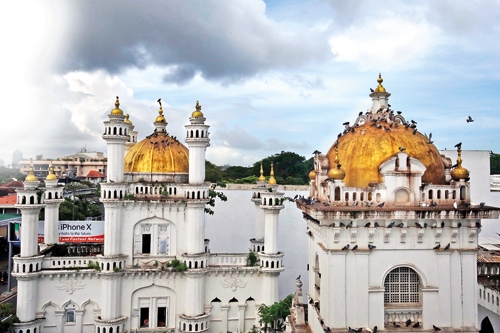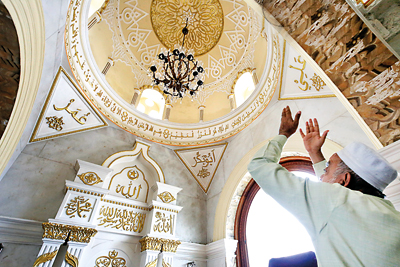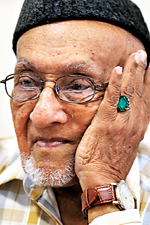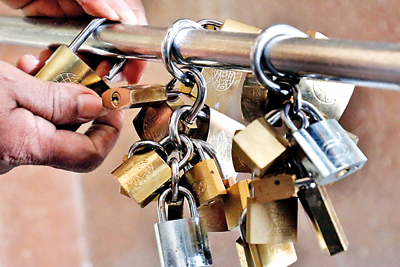Mosque of many faiths

The ancient Dewatagaha shrine mosque set in the heart of Cinnamon Gardens and below, a man in earnest supplication. Pix by M.A. Pushpa Kumara
Standing tall amidst the hustle and bustle of Lipton’s Circus in the very heart of Cinnamon Gardens, the beautiful white and gold minarets of the Dewatagaha shrine and mosque gently rise towards the sky.
Blending in well with its neighbour, the majestic Town Hall, the muezzin’s call to prayer reverberates five times a day. There is speculation that the British may have built the Town Hall to reflect the dome of this Islamic place of worship said to be one of the oldest in the country.
However, it is not only Muslims who are drawn to the Dewatagaha shrine and mosque believed to be more than 200 years old but also those of all faiths from across the country, for many will vouch about the miracles that occur at the shrine of the saint, Ash Sheik Usman Waliullah.
It is on Tuesday in the Islamic holy month of Ramazan during which Muslims engage in fasting and prayer that the Sunday Times visits the Dewatagaha shrine and mosque. Ramazan concludes with Eid-ul-Fitr, on the sighting of the moon predicted for Saturday, June 16.
While several men with and without their short, rounded skullcaps hold up their hands in supplication, in walk three women.
Three sisters from Dehiwela, they are Sinhalese, and have come to call on the saint to deliver them and their children from the evil utterings of those who wish misfortune and doom on them. In their hands they carry padlocks with keys.
 They go to a moulana (priest) seated behind a curtain in the women’s section, adjacent to the shrine who listens to them intently and murmurs prayers after which the three sisters walk up to a railing close to a huge lamp which faces the shrine and lock their padlocks to big bundles already there. Above the padlocks are strips of green ribbons also tied to indicate favours asked through vows made at the shrine, green being the colour used by Prophet Muhammad, the Founder of Islam.
They go to a moulana (priest) seated behind a curtain in the women’s section, adjacent to the shrine who listens to them intently and murmurs prayers after which the three sisters walk up to a railing close to a huge lamp which faces the shrine and lock their padlocks to big bundles already there. Above the padlocks are strips of green ribbons also tied to indicate favours asked through vows made at the shrine, green being the colour used by Prophet Muhammad, the Founder of Islam.
“Ape pavul hathurangen pravesham karanna kiyala thama illanne,” says one sister, close to tears, explaining that they are seeking protection for their families from their enemies, as another explains that their children cannot hold down jobs and there is constant bickering and quarrelling among them.
The third with a sweet-smelling bottle of oil in hand adds that evil is being cast on them by some of their own relatives, as another woman with head covered walks into the women’s section carrying joss-sticks and in a room demarcated by a tinted glass through which the shrine is visible, there is a woman in deep prayer. Another woman with a pottu stands before the shrine in fervour.
Before the history of this place of worship flows forth from Religious Coordinator Mohamed Buhary Mohamed Farook — now 87, who has served here since the early 1980s and seen the solitary tall date-palm tree which is now no more like the Dewata-gaha which had been here earlier — we are shown offerings of gold and silver from those who have sought and been granted favours.

M.B. M. Farook
A Sinhala soldier who had suffered severe gunshot wounds on his arm during the war and had been told that there was nothing except amputation, had walked in and placed a vow, relates Mr. Farook. There was no amputation and the arm healed and the ecstatic soldier donated a miniature arm made of gold, which is in a cushioned jewellery box alongside another arm of silver. Other gold miniatures include a Koran.
But this is not all, says Mr. Farook walking us out of the office and onto the pavement very close to the busy Hospital Square including the National Hospital and the Eye Hospital, to point up towards some minarets, the symbol of spiritual illumination, glistening gold and white after a mild but sudden shower of rain. These had been built in thanksgiving by a Tamil who had lost a gem and having made a vow here found it once again.
The architecture, dating back to 1885, has Moghul influences, according to Mr. Farook.
Dominated by the dome of the building housing the shrine, the entrance with walls on either side facing the main road opens into the passage to the shrine room. The chambers where women can pray and offer their respects to the saint are on the left and the three-storey prayer halls for the men to the right.
The 36-foot pigeon tower, meanwhile, is a square-like structure, said to have 500 ‘holes’ to shelter dozens of these birds and as we watch, a worshipper steps out of the shrine area to scatter grain bringing down a large flight of grey-black and amidst them a few white pigeons. They peck at the grain and then have a sip and a quick bath in the large basins of water kept there.

Padlocking away the evil utterings
The history of the Dewata-gaha palli we garner from information on the web, which is confirmed by Mr. Farook……even though the resting place (ziyaram or tomb) of the Muslim saint Ash Sheik Usman Waliullah was discovered in 1802, when he arrived in the island is shrouded in the dim mists of time. It had been in 1802 that a Sinhalese woman hawker of oil while on her daily rounds from Maradana through the cinnamon estate to houses on the other side, tripped on a tree-root, with her pot of oil shattering to smithereens.
Distraught over the mishap for she was the sole breadwinner, she had sat there in worry when someone in green attire with a long grey beard appeared, gently asking her to fetch a new pot. When she returned, he had pressed the ground with his feet and oil had gushed out. Happily filling the pot, when she thanked the stranger, he had but one request — to tell her Muslim customers what had happened and show them the place. When she did, physician Mamina Lebbai Mesthiriyar, had gathered several others and accompanied the woman to the spot where stood a Dewata-gaha and a fruitless date palm tree. They had then recited prayers here with Muslims thereafter frequenting the site. Soon after, Mamina Lebbai Mesthiriyar had had a dream in which the saint revealed his name and described the place where he was buried thus….. “There was a huge Dewata tree a few yards away from the foot-end of the grave and the fruitless date palm a few yards away from the head-end of the grave.”
The rest is history – with the mosque being vested with the government in 1983 by Muslim Religious and Cultural Affairs Minister M.H. Mohamed and handed over to the Wakf Board. Soon after, the old prayer mosque had been demolished and a spacious three-storey modern mosque built.
Even though opinion among Muslims is divided about shrine-worship, like during its humble beginnings, even though centuries have passed, the shrine attracts the faithful of all faiths…..and they come with implicit confidence that whatever they seek will be fulfilled.


